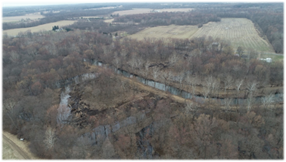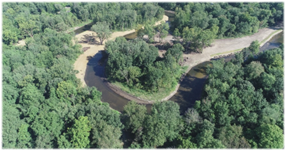Tribal stewards: A river restoration for the record books
In 2011, the Pokagon Band of Potawatomi Indians received funds from the Great Lakes Restoration Initiative to plan a restoration project on the Dowagiac River.

As of 2022, Michigan has 12 federally recognized Native American tribes. These tribes vary in their sizes, histories, and cultures, but a common element surrounds all indigenous people in North America: a connection to the natural world. Despite centuries of colonization and forced assimilation, many tribes still work hard today to ensure this natural world is stewarded and managed properly for the benefit of all.
Today, all of the tribes of Michigan have their own departments or employees devoted to conservation and natural resource management. Each tribe has a different organizational structure that may include conservation, fisheries, or wildlife departments, depending on the needs of their communities. Such tribal departments are engaged in a variety of projects, often exercised through their treaty rights, aimed at stewarding, protecting, and restoring the natural resources of Michigan. Below is one such project that showcases the breadth and impact of tribal nations in Michigan on the beloved natural resources all Michiganders enjoy.
Pokagon Band of Potawatomi Indians
The Dowagiac River in southwestern Michigan is a beautiful and unique coldwater river fed by the Kalamazoo glacial moraine, unlike most nearby rivers which are cool or warm water. Unfortunately, between 1901 and 1928, the river was dredged and straightened, resulting in the loss of half of the river’s length and a disconnection from the river’s floodplains. A concrete dam built in 1928 just 7.5 miles downstream of the Pokagon Band of Potawatomi Indians tribal properties caused further degradation by disconnecting fish and other aquatic species from the rest of the river. These changes resulted in the river having greater water level fluctuations and faster moving water which ultimately led to excessive erosion and steep banks. The once clear water of the Dowagiac River became cloudy and fish spawning areas disappeared under the silt and sand.
Despite the Dowagiac River’s destruction, the people of the Pokagon Band of Potawatomi Indians desired to see the river restored to a natural state. The Pokagon have lived in the region for thousands of years, and despite the near extermination of the Band by the American government, the Band persists to this day and actively manages and protects the resources of the region as one of Michigan’s federally-recognized tribes. In 2011 the Pokagon Band received funds from the Great Lakes Restoration Initiative to plan a restoration project on the river. With further financial support and input from numerous agencies, the Pokagon Band’s Dowagiac River Restoration Project was born.
The goal is to restore five historic meander bends in the river and 53 acres of wetlands through the reconnection of the river to its floodplains. Further, the project is using natural channel design to create complex in-stream habitats for aquatic species and restoring the riverine corridor with the planting of native species.
Restoration begins
The project has taken over a decade of planning, preparation, and partnership. At last, in 2021, the concrete dam downstream of the restoration project was removed by the Southwest Michigan Planning Commission and supported by the Band. This removal allowed fish and other aquatic species to explore and find suitable habitats in an additional 159 miles of the river and its tributaries for the first time in almost a century. This presented significant opportunities to the Pokagon Band as tribal citizens are now able to fish from tribal properties for species that have not been present in tribal waters for almost a century. The Pokagon Band thinks in seven generations, whereby the restoration of the river system significantly benefits all those yet to come (for the next seven generations) and helps to re-establish lifeways that have been lost by past generations.
In the spring of 2022, the Pokagon Band began restoring the natural shape and flow of the river. This included the removal of trees, installation of soil erosion control measures, and the excavation of old meander bends. Following excavation, native species were planted throughout the site. These plants will be crucial in restoring habitat and preventing erosion.
The images below help reveal the drastic change in the river during this restoration.


With the restoration of historic meander bends to the river system and reconnection to the floodplain, a number of benefits are both evident and anticipated. The river in this section will be allowed to overflow its banks more regularly and more evenly creating fertile soil. Also, as these waters overflow onto tribal properties, sediments will settle from the river water to the land, allowing the water re-entering the river system to be cleaner and clearer. The restoration has also provided many different types of habitats for multiple wildlife species including young and adult fish, as well as aquatic insects, amphibians, reptiles, and waterfowl. With the river length being doubled in this section of river it will also be more scenic for water recreation enthusiasts, having lower banks, a winding path, and native plantings along the restored corridor.
The Pokagon Band’s Dowagiac River Restoration Project is an example of what a functional and active river can and should be. Jennifer Kanine, Ph.D., the Director of Natural Resources for the Pokagon Band of Potawatomi Indians said that “most of the people alive today do not realize how disturbed and dysfunctional many riverine systems are because they were not alive to see them as they once were, they have only known them in their current form. Through the restoration of historic meander bends, we can once again help to provide many habitat types for multiple wildlife species and provide an area for the floodwaters to go.” The Pokagon Band’s Dowagiac River Restoration Project is a major accomplishment that will have lasting impacts for the human and environmental communities alike. The Pokagon Band is excited for their accomplishments, but remains, perhaps, more excited for the benefits to come.
Learn more
Michigan State University Extension highlights that projects just like this one are occurring all over Michigan every day. Michigan’s 12 federally recognized tribes remain active stewards of our natural resources and are working diligently to ensure these resources for the coming generations. If you want to learn about another tribal project, check out the article, “Fire as a Friend,” or consider using this map to find the tribe nearest you that may be working on managing the natural resources in your county or township.
Avery Tilley graduated with dual degrees in Fisheries and Wildlife, and Genomics and Molecular Genetics from Michigan State University in 2023. He is a citizen of the Cherokee Nation and a Texan. Tilley is pursuing a Doctorate of Veterinary Medicine at the University of Georgia with hopes to further a career in tribal wildlife medicine.



 Print
Print Email
Email


